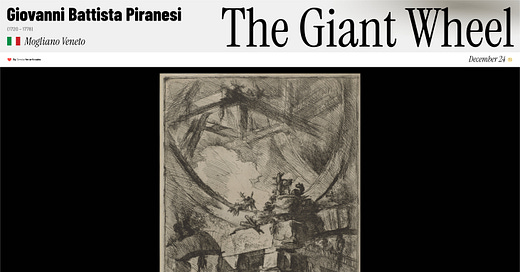Welcome to Tormius Nexus
In today’s D7ART section, we introduce…
What:
The Giant Wheel is an etching by Italian artist and architect Giovanni Battista Piranesi (1720–1778), known for his elaborate architectural fantasies and depictions of ancient Roman ruins. This work is part of Piranesi’s famous Carceri d’Invenzione (Imaginary Prisons) series, which features vast, fantastical spaces filled with complex architectural forms and machinery. The giant wheel dominates the composition, surrounded by crumbling stone structures and tiny, isolated human figures. The wheel, which appears to be part of an enormous, unclear mechanism, adds a sense of scale and mystery to the dark, labyrinthine setting.
Who:
Giovanni Battista Piranesi was born in Mogliano Veneto, Italy, and became one of the most celebrated etchers of his time. His work combined his deep knowledge of architecture with a vivid imagination, creating surreal spaces that evoke feelings of grandeur and desolation. Piranesi’s Carceri series is particularly known for its depiction of vast, oppressive spaces, often interpreted as metaphors for the human condition or the imagination’s boundless capacity for creation and destruction.
Where:
The architectural setting in The Giant Wheel is imaginary, rooted in Piranesi’s fascination with classical ruins, prisons, and mechanical inventions. Although there is no specific location, the etching draws on ancient Roman architecture, particularly monumental structures like aqueducts and fortresses. The cavernous space is reminiscent of both Roman engineering feats and the fantastical, dreamlike spaces found in the darker corners of the human psyche.
When:
This work is part of the Carceri d’Invenzione series, originally published in the mid-18th century. During this period, Piranesi was producing some of his most famous and innovative etchings, blending his architectural knowledge with an exploration of fantastical, often dystopian visions. His Carceri series, which grew in complexity over time, remains one of the most influential bodies of work in the history of printmaking.
How:
Piranesi used the etching technique to create intricate, detailed line work, employing dramatic contrasts of light and shadow to build a sense of depth and scale. The chiaroscuro effects, with light filtering through the massive wheel and the towering stone structures, add a sense of menace and tension. The etching’s densely packed details, from the textures of the stone to the mechanical elements of the wheel, create a visually overwhelming experience, characteristic of the Carceri series.
Why:
The Giant Wheel explores themes of confinement, power, and the tension between human ambition and limitation. The wheel, an ambiguous, looming presence, could symbolize the mechanized nature of fate or the ceaseless motion of time. Piranesi’s imaginary prisons are often interpreted as psychological or philosophical spaces, where architecture becomes a metaphor for the struggles of the human mind. In this piece, the small, insignificant human figures underscore the sense of existential despair and entrapment within an incomprehensibly vast world.
This text was created with the help of ChatGPT-4o. If any information is not entirely correct, I would appreciate a revision to help me learn, thank you.
Feel free to share your thoughts by sending a reply and we can chat about it!



